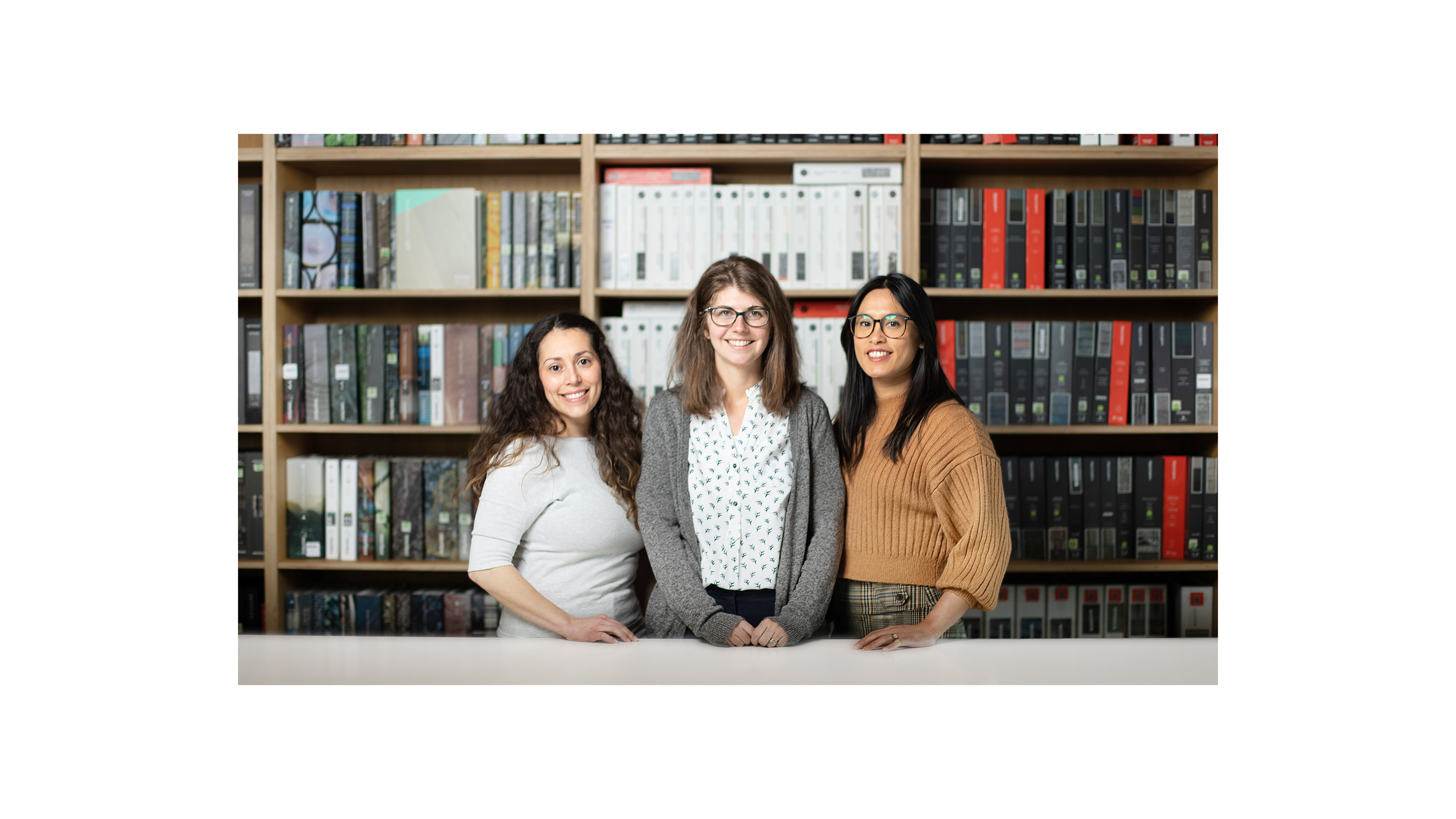The Do GOOD / Be WELL scholarship encourages Ankrom Moisan employees to research an open-ended topic of their choosing and share the practical results of their findings with the firm, industry, and community at large. The scholarship, started in 2017, is sponsored in memory of former AM employee Carolyn Forsyth, an inspirational leader and unyielding force for change. Intended to honor her legacy of sustainability, equity, innovation, advocacy, education, and leadership, the DGBW scholarship elevates and empowers new and inspiring ideas within Ankrom Moisan and the broader field of architecture, pushing us all, as the name implies, to do good and be well.
As the recipient of the 2022 Do GOOD / Be WELL scholarship, Cara Godwin encouraged Ankrom Moisan employees to not only learn about air quality but to measure their own. Cara implemented a program that provided home air kits, consisting of a HEPA filter and an air sensor, to be checked out and taken home.
By using air sensors that provided a real-time air quality score, participants were able to better understand how opening windows, cooking, and running exhaust fans impact indoor air quality. The program also encouraged people to be Citizen Scientists by gathering data in their own respective environments and automatically sharing it to the Purple Air network map in real time, increasing the pool of scientific knowledge that design decisions can be made from.
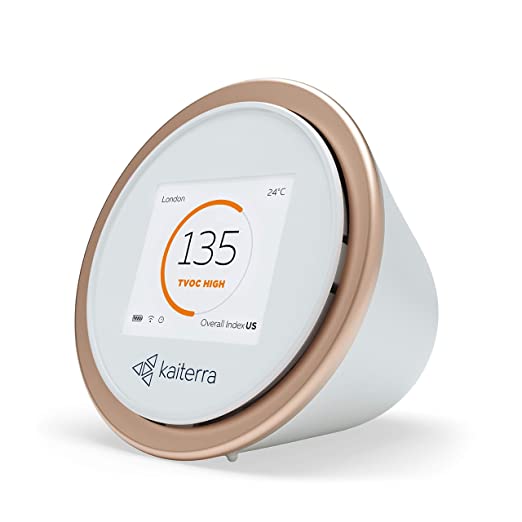
Kaiterra Egg air sensor utilized in Cara’s research study.
The (Overlooked) Importance of Air Quality
Designers of the built environment are deeply familiar with energy scores and water scores, but air quality has been less defined and is often left unconsidered—Cara hopes to change that.
Cara has lived in the Methow Valley for twelve years now, an area which often deals with wildfire smoke. Cara and her husband had indoor air quality at the front of their minds when they built their home in 2011. Their son has had respiratory issues since birth and asthma since just before his second birthday, which led the pair to learn more about indoor and outdoor air quality. “We are a ‘Clean Air Methow Ambassador,’ we have been interviewed on a podcast, interviewed by a health reporter, and often my son’s photo and story are used in discussions about air quality,” Cara stated. “This scholarship seemed like a natural way to share this information with coworkers and hopefully have a positive impact on future building designs.”

The Godwins: Cara, her husband, and her son.
Even if you have not personally noticed issues with air quality, you are likely being affected by air pollutants. More and more research talks about PM2.5 – fine inhalable particles with diameters that are 2.5 micrometers or smaller – and their long-term effect on our lungs. PM2.5 sources include chemical exhaust from industries and automobiles, wildfire smoke, pollen, dust, and hundreds of other chemicals. EPA and other clean air groups are focusing on education for people to understand air scores and sources. This study helps expand those efforts.
The Findings from the Air Sensors
The most common response from kit recipients was about cooking. It is uncommon for range hoods to be used every time a cooktop is utilized, though that is the recommendation. After receiving their results, many participants noted they will use the hood more often. One participant noted that their charcoal recirculating exhaust fan was not adequate on its own and required a window to be open for proper ventilation.
Another finding was that pets do not seem to have a negative impact on air quality. Running the HEPA filter had noticeable positive impacts for participants with seasonal allergies and asthma.
In a survey filled out after using test kits at home for a few weeks, participants were asked what they might do differently in future designs after receiving their own personal air quality scores. Several responded by advocating for electric cooking over gas. A few mentioned advocating for operable windows and making operable windows open further. There is a desire to avoid using charcoal recirculating fans for kitchen exhaust. Others mentioned trying to design for air changes above code minimum and running the whole house exhaust longer.
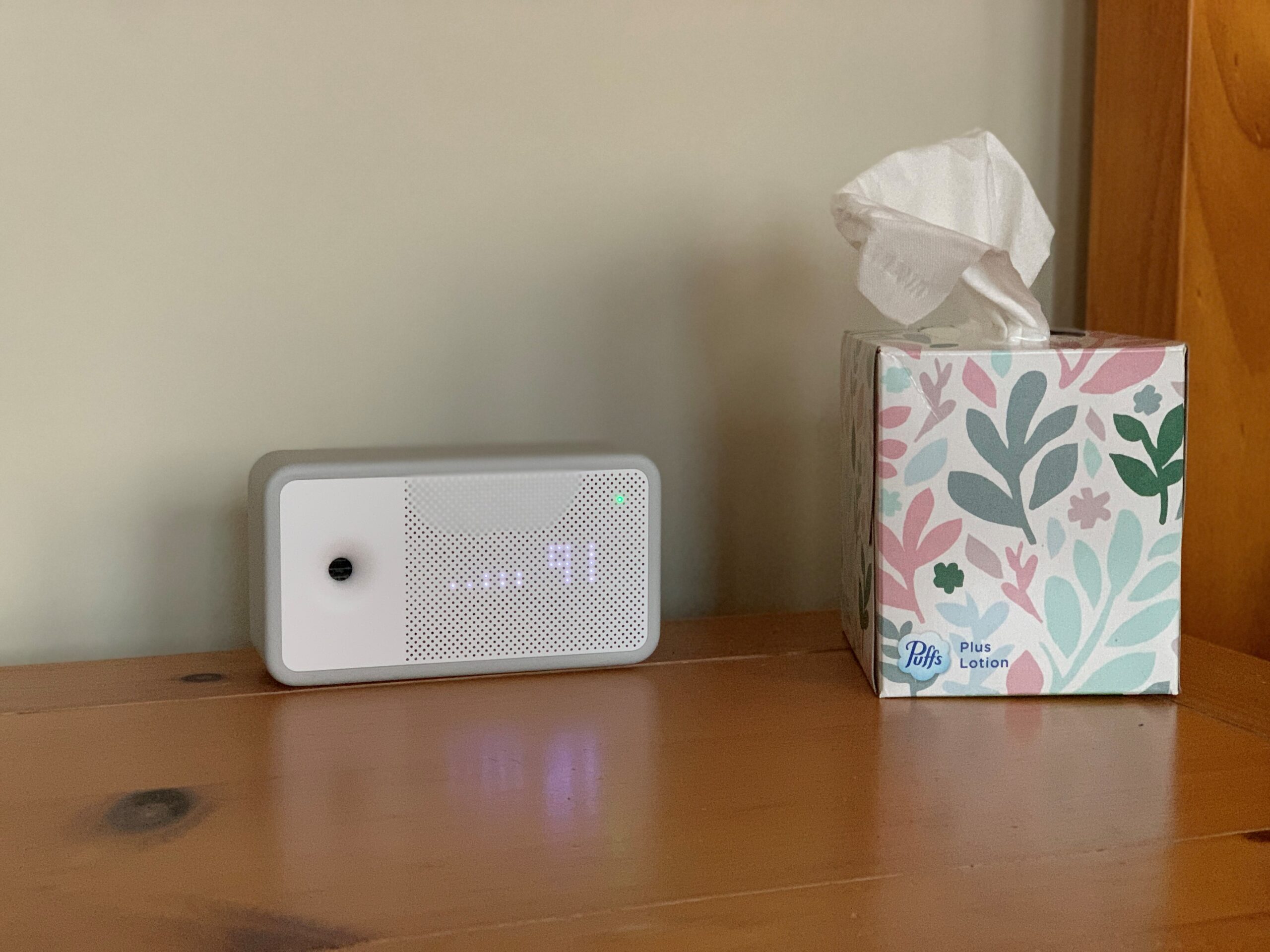
Awair air monitor in use.
Swapping Cooktops to Improve Air Quality
During this time, Cara was looking into replacing her propane cooktop with an electric induction range and took the opportunity to tie her search in with her research proposal, using the information gathered from the use of the HEPA filter and air sensor to guide her purchase decision, and sharing the results with the firm. This choice was supported by Cara’s experiences with indoor air quality monitors, as they have demonstrated that cooking has the greatest impact on air quality in a home. Cara swapped out her propane cooktop for a gas one, as well as her exhaust hood in hopes that a quieter exhaust hood would be used more. Finding the right induction range was the tricky part. The options seem limited, and costs vary greatly.
Her research found that the difference in cost is dependent on the size of the magnet, and that the size of the magnet, or burner, should match the size of the pan being used. This is because a pan too large for a burner will not heat up efficiently, and food will not be evenly cooked. The main obstacle in sourcing a new cooktop was related to finding black appliances, which have even fewer options. In the end, Cara switched to black stainless steel. For the exhaust hood, quieter options require an 8” exhaust duct. Cara’s pre-existing duct was only 6”, meaning it was not feasible to replace the exhaust duct in the roof assembly, so the new hood is only slightly better in terms of noise level.
For the actual experience with induction cooking, Cara states that “it has been a real pleasure to cook with. The cooking is more even, and water does boil as fast as everyone says. There is also peace of mind with all the recent news of harmful chemicals coming from gas cooktops.” The original concern with the propane cooktop had to do with CO2 levels rising during seasonal times of wildfire smoke when fresh air is closed off, but the benefits of an induction range have expanded to all year round. Cara recommends induction over gas to anyone building new construction, and in her case, with someone with respiratory issues in the house, switching is a great option.
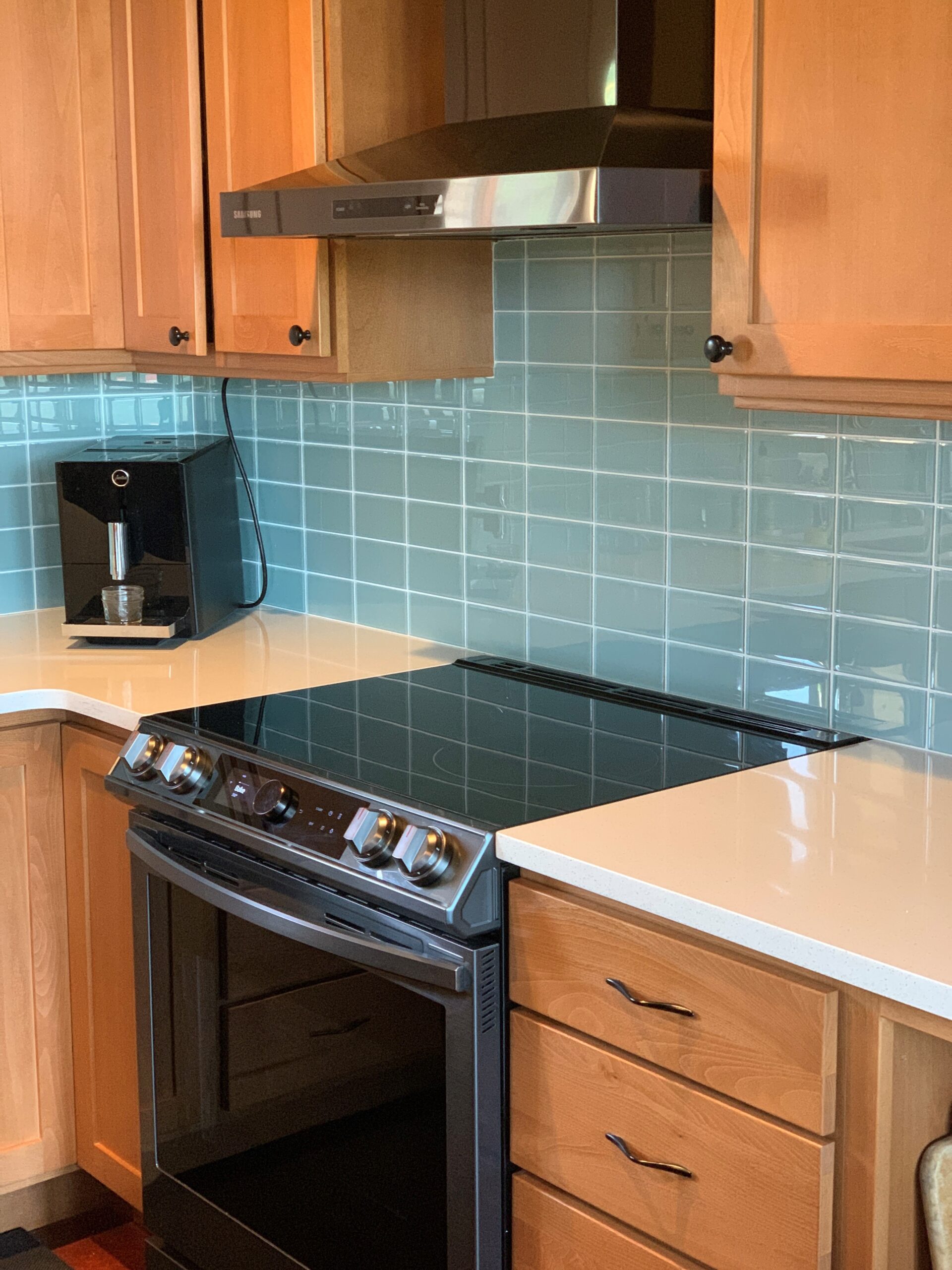
Cara’s new black stainless steel induction range with hood.
Applying the Research to our Designs
If you have not experienced it yourself, you probably know someone who has had to alter their plans or take medication due to allergies to pets, perfume, or wildfire smoke. At Ankrom Moisan, we talk about designing for all users and that should include designing for respiratory sensitivities.
This study will hopefully help influence future building designs to take user sensitivities into account, and therefore create buildings that are a haven from pollutants and irritants during times of poor outdoor air quality. And in times of good outdoor air quality, our spaces should reduce known contributors to poor indoor air quality.
One example of how we can design more inclusively is to consider air quality and pet allergies. Many residential communities today allow dogs but that can exclude people with allergies from living there—unless the air quality improves and the building, as well as furnishing, is designed to minimize pet dander. Our designers, armed with the findings from Cara’s research, can also advocate for features that will benefit everyone such as electric induction ranges, quieter exhaust hoods and operable kitchen windows
Though indoor and outdoor air quality is a consideration that is often forgotten, Cara’s DGBW research program illustrates the importance of bringing all aspects of wellness into a building’s design, and redefines how we explore beyond, changing what designing for inclusiveness can mean.

By Cara Godwin, Practice Manager
Where are the Women?: Closing the Gap
Backed by Ankrom Moisan’s Do GOOD / Be WELL research scholarship and galvanized by a noticeable lack of women in architecture, Amanda Lunger, Elisa Zenk, and Stephanie Hollar set out to determine why women are not at the forefront of the field, and what can be done to get them there.

Elisa Zenk, Stephanie Holler, and Amanda Lunger in AM’s Portland office.
The Research
Amanda, Elisa, and Stephanie did this by administering all-office surveys, holding conversations with women in the field of architecture, evaluating their own individual experiences at Ankrom Moisan, and conducting case-studies that observed the structure and operation style of women-led architecture firms. The all-office survey contained twenty-two questions and was answered by 158 participants, both male and female. As for the conversations with women in architecture, fourteen of those women were current AM employees, and ten of them former AM employees.
What these conversations, surveys, and case studies revealed was eye-opening, but not out of left field. A substantial disparity exists between men and women’s experiences in the architecture industry. This article will highlight the primary problems afflicting women in architecture and provide methods for both firms and individuals to combat and overcome them.
Amanda, Elisa, and Stephanie identified 6 key issues:
- An Unclear Path to Leadership
- Burnout
- Pay Disparity
- Balancing Motherhood and a Career
- The Road to Licensure
- Feeling Out of Place
While these findings may paint architecture as a lopsided and unfair industry, the good news is that there are many ideas and suggestions for how to boost equity and support women in architecture. Some of the ideas, presented at the 2022 AIA Women’s Leadership Summit in San Jose, California, which Amanda, Elisa, and Stephanie attended, range from celebrating the successes of other women, reminding individuals to ask for help when needed and remembering that it’s okay to say no, to making time to mentor younger women, and delegating and sharing opportunities with other colleagues. Some suggestions are as simple as taking ten minutes at the beginning of every meeting to create a psychological safety zone, so that everyone feels like they belong at the table and can express themselves without fear of rejection.
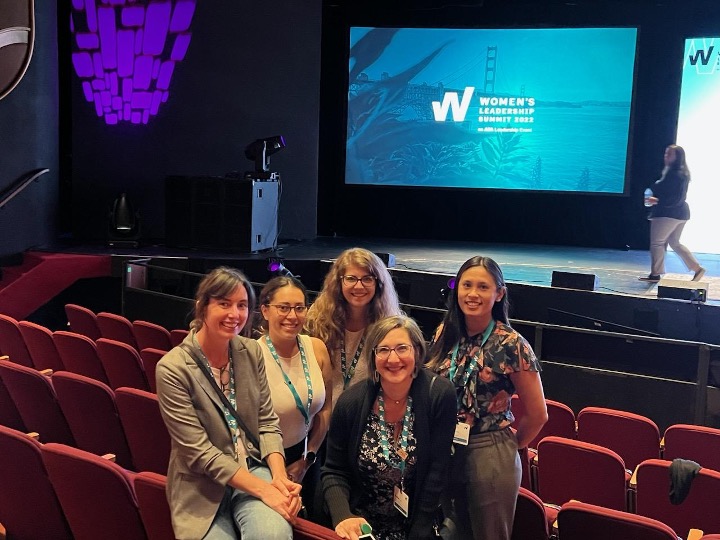
Jennifer Sobieraj Sanin, Elisa Zenk, Stephanie Hollar, Mariah Kiersey, and Amanda Lunger at the 2022 AIA Women’s Leadership Summit.
Additionally, Amanda, Elisa, and Stephanie have provided their own insights for how Ankrom Moisan, and other architecture firms, can remedy the gap between men and women in the field. Other potential solutions suggested by a variety of sources—from interviews with women in the field and from solutions other firms have implemented—synthesized through Amanda, Elisa, and Stephanie’s research will be interwoven with the six key issues they identified.
An Unclear Path to Leadership
Leadership is a common goal for both men and women in architecture. 70% of the people surveyed by Amanda, Elisa, and Stephanie stated that they would like to be in a leadership position. Unfortunately, women seemed to feel that goal was out of reach. One employee surveyed responded that they “truly wish to hold a leadership position someday but have zero expectations that they would ever make it into [one].” Another answered that a leadership role was desirable but seemed like “you are inundated with paperwork and peopling and are no longer a part of the design of architecture.” The desire to still be a part of hands-on design processes may be a factor in forgoing the pursuit of leadership roles, but it is not the sole reason leadership can feel out of reach to female architects.
This dashing of expectations may be attributed to the observation that the path to leadership roles is less than clear for women in architecture. 35% of women felt that they didn’t understand the path to leadership at Ankrom Moisan, whereas only 20% of men felt that the road to leadership was beyond their grasp. There were some other survey respondents, however, who saw this lack of clarity regarding career advancement as a challenge, stating “I have no one to look up to that looks like me. So, I’ve decided to become that person – a leader.”
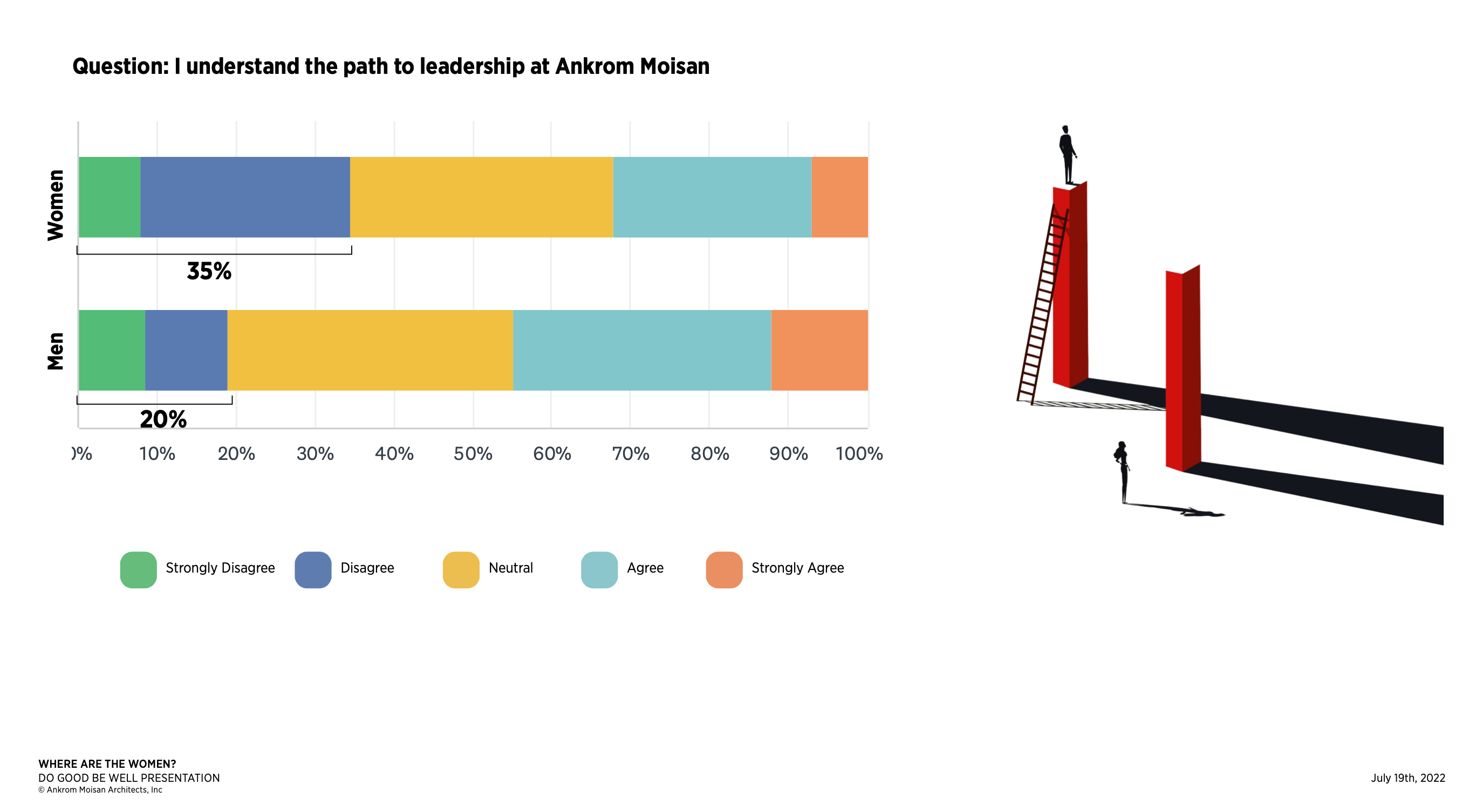
Survey results highlighting an unclear path to leadership positions.
One reason the ladder to success might appear so esoteric is that a lack of evaluations and constructive feedback can work as a barrier against career growth and advancement. Luckily, through their research, Amanda, Elisa, and Stephanie were able to gather ideas for how to break down this barrier and make the path to leadership clearer. These suggestions range from designing strategic plans like PEP employee evaluations and check-ins for developing staff into leadership roles and standardizing them across teams, to adding peer reviews to the evaluation process for a broader spectrum of feedback.
Taking these suggestions to heart, Ankrom Moisan’s Career Pathways Program establishes resources for employees to understand the path to leadership, making it the most significant action item to come from Amanda, Elisa, and Stephanie’s research. Another key solution that emerged from this project was the hiring younger staff for employees to mentor and lead, thus creating ‘inward facing’ roles for many of the architects that desire to hold a leadership position and providing younger hires with mentors that they can look up to and learn from.
Burnout
When employees take on additional work and responsibilities beyond their regular role, they become overworked and have little energy left for their regular duties. Adding newer, younger staff to architecture teams would also help solve the burnout problem, which is primarily caused by a staff shortage. Unfortunately, it seems that burnout happens to women at a disproportionate rate. 46% of women have felt overwhelmed by their responsibilities at work, which is drastically more than the 29% of men who feel that way.
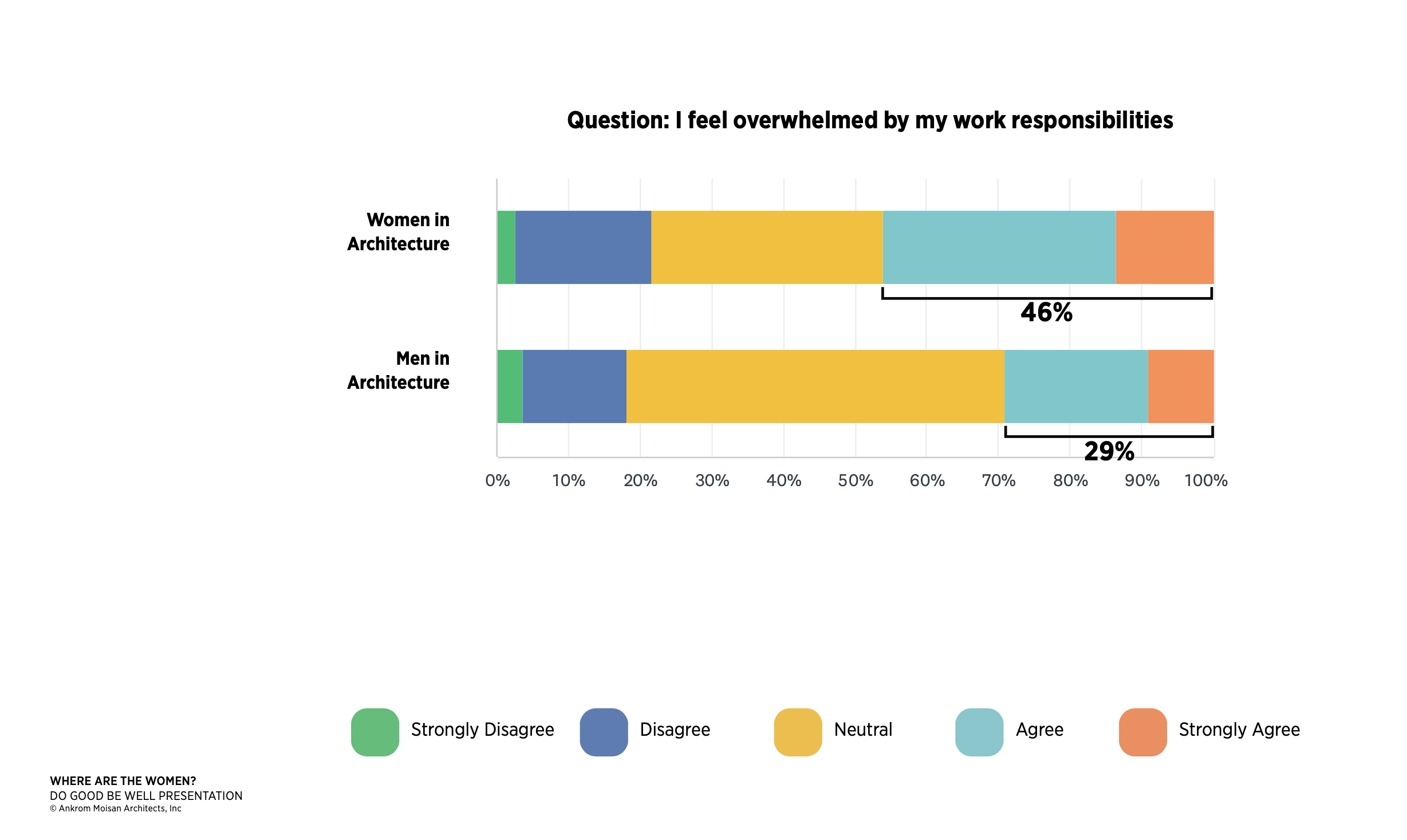
Survey results related to staffing, workload, and burnout.
The feeling of being overcome by professional obligations often prevents employees from wanting to advance in their career, as well, as that advancement presumably comes with even more responsibility. One survey response elucidated, “I enjoy working with the people and the clients we have, but not always having the resources to staff a project can lead to burn out, make it hard to want to be involved in any initiatives, and really leads to questioning what it means to [want] to advance.” Some of the solutions suggested by Amanda, Elisa, and Stephanie to combat this are to focus on hiring and retaining emerging professionals, ensuring that employees who feel overwhelmed have the opportunity to move to less demanding projects with lighter workloads, and designing strategies to ensure that staff are not spread too thin, or constantly in ‘survival mode.’
Pay Disparity
It’s common for employees who take on extra work to receive a pay raise with their new responsibilities. This is not always the case, though, and sometimes individuals must negotiate to secure an increase in their salary. Yet again, this is an area that is not entirely equitable. In fact, negotiations have the largest discrepancy in attitude between men and women in architecture. 46% of women surveyed admitted that they do not feel comfortable asking for a raise or a promotion, which compared to male respondents’ 11%, is eyebrow-raising. One discerning observation that reveals why this is the case indicated that “women typically ask for a raise after they’ve [proven] that they’ve done something, but men ask for a raise in anticipation that they’re being asked to do something.” Ultimately, this means that women may be doing more work for less reward than their male counterparts, as they feel they must go above and beyond before they are entitled to additional compensation.
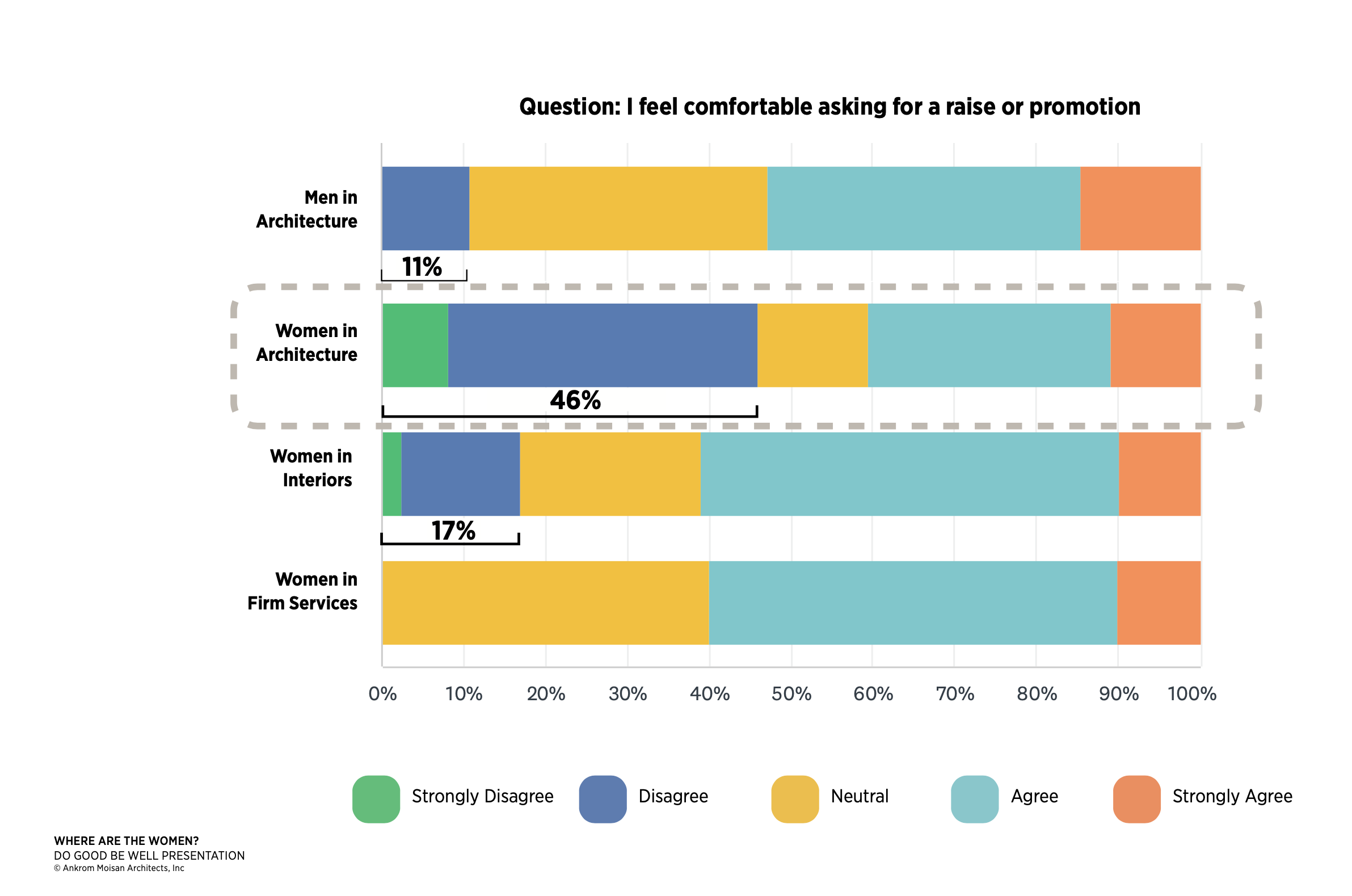
Survey results related to negotiations.
Another component to this issue is pay transparency. Not knowing the pay range for a position when entering negotiation can set a person up to settle for less than they deserve. Additionally, a lack of transparency can prevent people from wanting to negotiate in the first place. As one survey respondent put it, “I haven’t been super confident, and I didn’t want to come across as pushy. I also didn’t do it because I wasn’t aware what other firms offer.” A potential solution for this, it seems, is offering confidence and negotiation workshops for women while proactively checking in on pay and role satisfaction, ensuring that companies are candid about the salary ranges for all their positions prior to negotiations. A case study observing Jeanne Gang’s Studio Gang found that knowing the baseline salary for any given position is key for enacting change, for yourself and others.
Because pay has been ranked as the second most important aspect of an individual’s career in an AMA office-wide survey, just after work-life balance, being transparent about salary ranges is crucial for both recruiting and retaining employees. It’s known that staff who feel that they’re being paid below the market value are 49.7% more likely to search for a new job within the next six months in comparison to employees who feel they are compensated at or above the market rate (Payscale). While about a quarter of both men and women were unsatisfied with their earnings, there were 27% more women than men who felt that the pay range for their role was not clear enough. Proposed solutions for ensuring pay ranges are as transparent as possible include conducting regular pay audits to identify and correct inequities, publishing pay ranges for each role, and communicating with staff about how those ranges are determined.
Outreach is another method to secure the place of women in architecture that great strides can be made in. By talking with female architecture students, conversations can be started around fair wages and negotiation, so that the next generation of women architects are already equipped to face the challenges of the industry. Additionally, encouraging employees to take part in programs such as Architects in Schools, ACE Mentorship, and the Boys and Girls club can expose more youth to the field of architecture, ensuring that its future is bright, and that burnout no longer holds back staff from doing their best work.
Balancing Motherhood and a Career
One area that undoubtedly impacts women and their careers more than their male counterparts is having children. Of the surveyed employees, half of the men who responded did not believe that having kids impacted their careers, while only 30% of women could say the same.
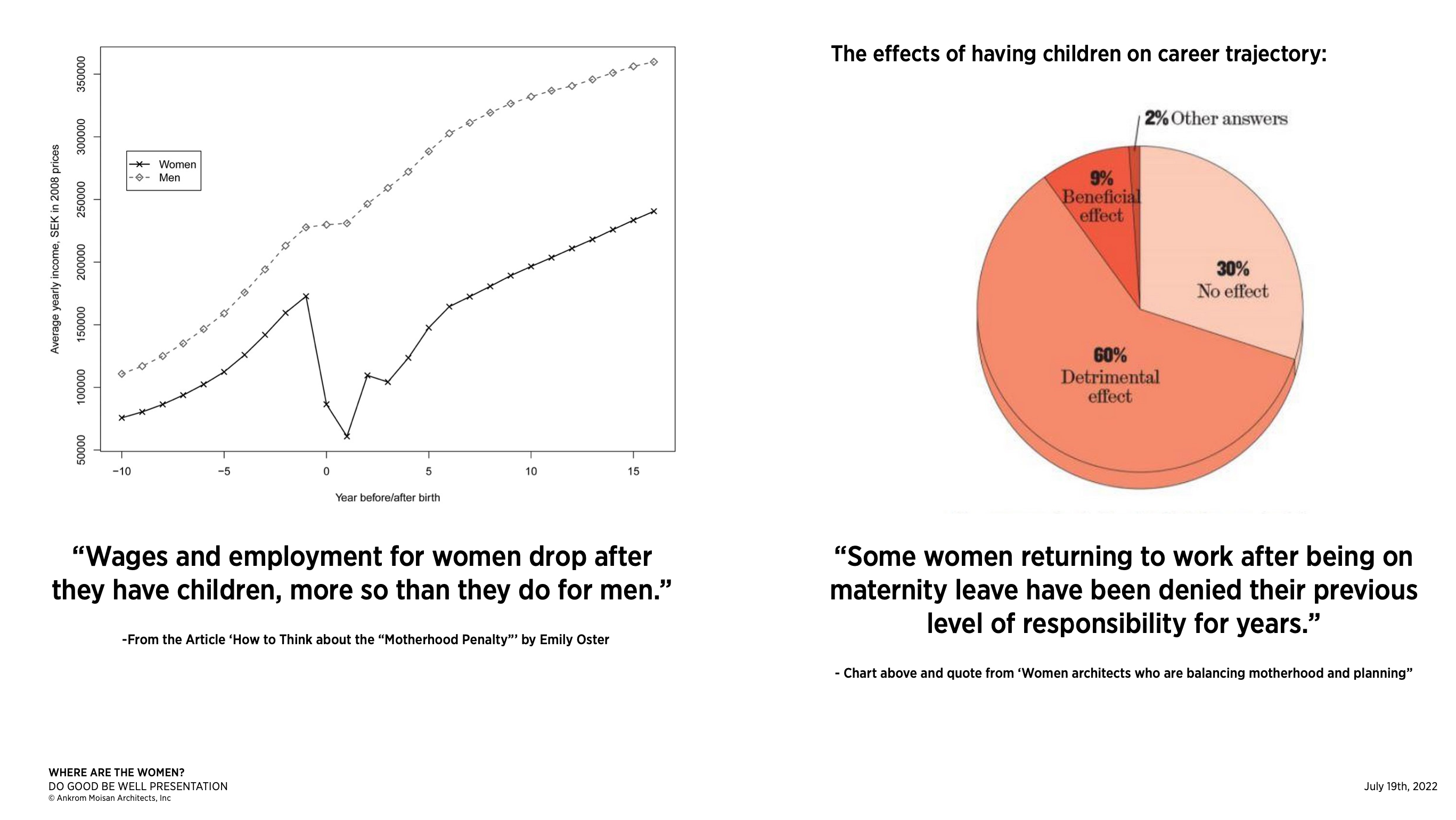
Graphic representations of the impact childbirth has on the careers of women.
Often, female architects start families at crucial career pinch points. If they choose to have children, it is not uncommon to return from maternity leave and be denied the same level of responsibility that they had previously held for years. The professional uncertainty tied to having children can mean that working women have to choose between one or the other. Some women try to juggle both motherhood and advancing a professional career but find that “being a mom and an architect, [it can feel] like both suffered.” Others draw a line, declaring that they are “not willing to sacrifice [their] personal or family time in order to advance [their] career.” Still, it’s hard not to feel like they are missing opportunities male counterparts don’t have to give up.
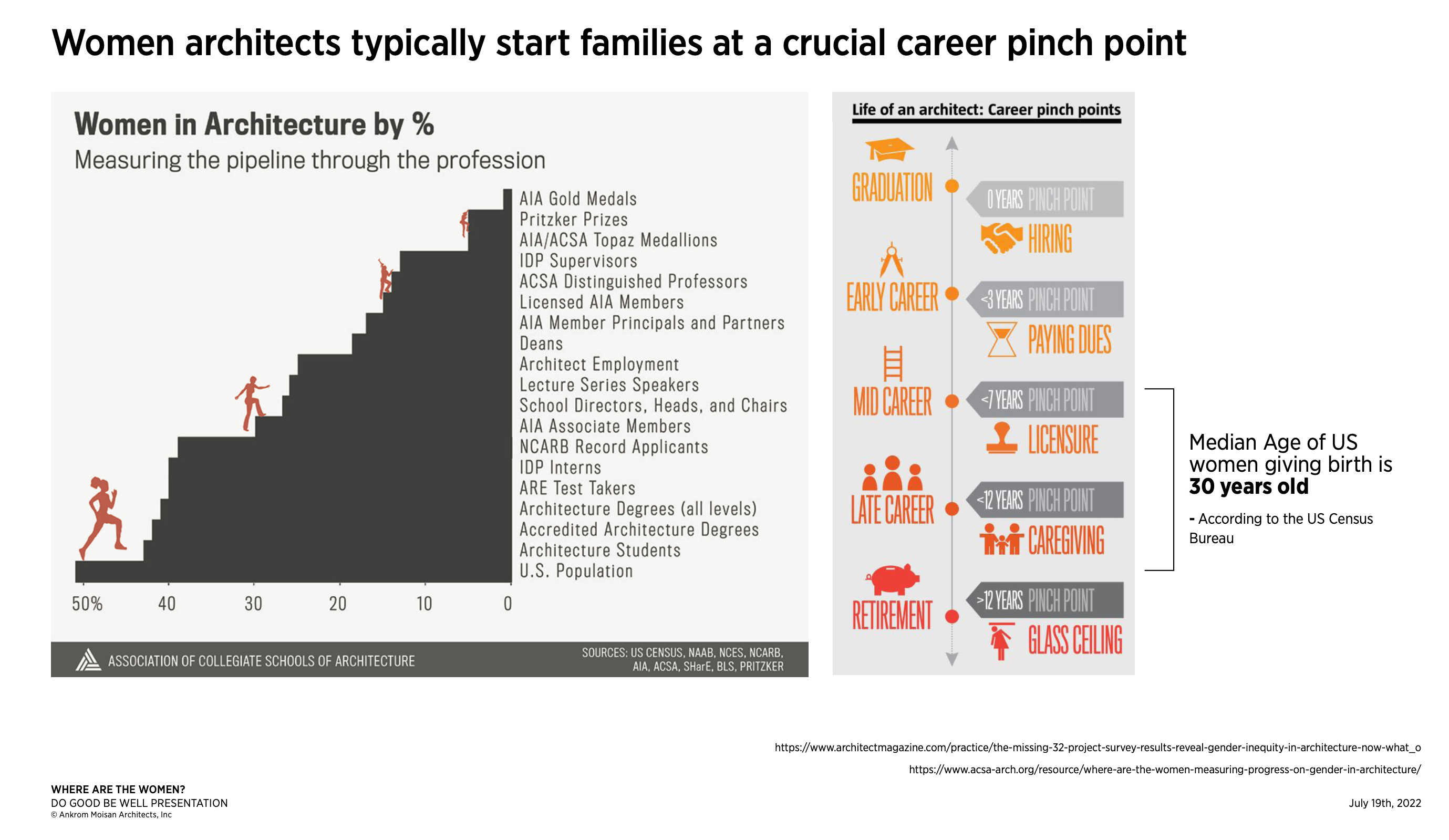
Illustration of how children come at a pinch point for many women’s careers.
There are ways to counter this feeling, though. Firms can provide better parental relief, for both men and women, normalizing child-rearing as the responsibility of both parents, rather than the sole responsibility of a mother. Promoting flexible work schedules can also help parents look after their children without sacrificing their career. Finally, firms can subsidize childcare, reducing the need for mothers to have to choose between their kids and their careers. At MOYA Design Partners, a childcare stipend is included as part of the work benefits project. Another case study found that Architects FORA, a 100% women-owned firm, is staffed completely remotely to provide as much flexibility as possible for employees with families. Whether children are young or old, this surely makes a difference in balancing professional obligations and a healthy home life.
The Road to Licensure
Motherhood is not the only thing that can set back a woman’s career. Licensure also serves as a roadblock on the path to leadership, especially for women. Although 61% of male architects are licensed, only 40% of women are. Employees that spoke to Amanda, Elisa, and Stephanie stated that “becoming licensed has been a daunting task.” Though supervisors can be supportive, encouraging employees to take the Architecture Registration Examination, “trying to excel with work responsibilities, office initiatives, and activities leaves little time for work-life balance, finding time to study for the ARE’s, and general decompression from it all.”
A healthy work-life balance is integral to both quality of work and quality of life. It’s necessary to protect this balance without penalizing employees who forgo studies and examinations that occur outside of working hours. Suggested solutions include incorporating ARE study and testing hours into staffing plans, reexamining the requirements to become a principal, and offering greater incentives for passing the Architecture Registration Examination and completing the process licensure. If these steps are undertaken, it’s possible that firms will see more licensed female architects, and women architects in leadership roles.
Feeling Out of Place
Outside of architecture firms, women face even greater challenges. “It’s difficult to be taken seriously as a woman in architecture, especially as a young woman,” one survey response said. “Not so much amongst other architects, but to GCs and consultants I feel like we have to prove our knowledge and worth 100 times over.” Another respondent noted that “it’s really hard when you’re asking someone like me, [a] thirty-something-year-old woman to bring in business. I have nothing to relate to 65-year-old men. How am I supposed to cultivate those relationships and bring in business?”
These challenges often originate from sexist stereotypes and beliefs regarding the kind of work women can do. The best way to put an end to beliefs like this is to train staff, especially men, to be allies to women in their field. It is imperative that men are aware of the challenges that women face in architecture, that way they can advocate for their co-workers in beneficial, productive ways. Firms can also accelerate the implementation of Diversity, Equity, and Inclusion strategies, and work with (or continue to work with) women-owned consultant firms to ensure that women in architecture are supported and celebrated.
Of course, it must be acknowledged that none of these issues stand alone. Many of them intersect in complex ways, preventing women from making the most of their experiences in architecture. For example, having children can prevent female employees from taking the time to complete licensure, which may bar her from working on more projects that could potentially advance her career to the level of leadership. Alternatively, having too much work and being spread too thin can stop her from mentoring younger staff, taking the ARE, or even deciding to have kids. These are tough choices that nobody should have to make; a career and a family should not be mutually exclusive.
Making Progress
What is worth celebrating most, though, is the fact that Ankrom Moisan is already executing many of the ideas recommended by the DEIB Council to fight these issues. Benefits like Flex holidays and remote and hybrid work options allow women with families to devote time to both their career and their children, on their own schedule. Programs such as AM Learn encourage employees to continue their professional growth through educational opportunities like the office’s regular Lunch & Learn sessions. Annual DEI surveys and listening sessions from The Diversity Movement promote conversations around these topics, certifying that everybody’s voice is heard. Do GOOD/Be WELL research projects provide an outlet for investigating critical issues to improve overall company culture.
Furthermore, Ankrom Moisan is committed to establishing clear career pathways, explicit evaluation criteria, and equitable pay transparency for all positions. This initiative led to the creation of the Career Pathways Program, a practical resource which summarizes the relationship between roles and titles in architecture, interior design, and practice services, with the hope of clarifying the pathways for professional development and growth available to Ankrom Moisan employees. Informative charts and diagrams illustrate our disciplines’ roles, role summaries, and evaluation criteria at all levels. All of this goes to ensure that our HOWs are fully embodied, every day.
There may be a lot of challenges when it comes to safeguarding gender parity in architecture, however, what Amanda, Elisa, and Stephanie have done with their Do GOOD/Be WELL research project is confirm that there are plenty of actionable solutions that guarantee the future of architecture is indeed female.

Amanda Lunger, Stephanie Hollar, and Elisa Zenk in the Portland office.

By Jack Cochran, Marketing Coordinator
Where are the Women?: The Research
The Do GOOD / Be WELL scholarship encourages Ankrom Moisan employees to research an open-ended topic of their choosing to discover and share the practical results of their findings with the firm, industry, and community at large. The scholarship, started in 2017, is sponsored in memory of former AM employee Carolyn Forsyth, an inspirational leader and unyielding force for change. Intended to honor her legacy of sustainability, equity, innovation, advocacy, education, and leadership, the DGBW scholarship elevates and empowers new and inspiring ideas within Ankrom Moisan and the broader field of architecture, pushing us all, as the name implies, to do good and be well.
For their research scholarship, Amanda Lunger, Elisa Zenk, and Stephanie Hollar ventured to ask: Where are the Women?

Amanda, Elisa, and Stephanie atop Ankrom Moisan’s Portland office.
The idea came to them naturally. During the firm’s 2020 Women’s Day celebration, Elisa noticed that some of the AM statistics shared didn’t seem to tell the whole story. “The women in architecture numbers were getting buried in the celebration of the fact that our office had this large percentage of women,” Elisa explained, “but when we looked into it, most of that percentage was made up of women in the interiors department and various overhead positions.” The real number of women in architecture was not as equitable as it could be. “I think I already knew this intuitively, that women are underrepresented in design roles,” Amanda disclosed, but “once we actually looked at those numbers, that was kind of shocking to me.” Stepping back to all architecture roles, not just design, women only make up 37% of architecture staff nationwide, according to AIA industry data collected in 2019. Amanda, Elisa, and Stephanie all knew that there should be more women in the industry and began to question why that was not the case. They were also interested in solving that problem at our firm, pushing AMA beyond industry trends.
After Amanda, Elisa, and Stephanie discussed this observation, they agreed that they had seen too many brilliant women, presumably on track for leadership, leave the field. “We were talking about these women who were really rockstars in the architecture department who were leaving,” recalled Amanda. “We were speculating as to why the industry seemed to have that problem.” Whatever the cause, it was clear that some women were dissatisfied with their experiences in architecture.
Stephanie recognized that the issue of women in architecture leaving Ankrom Moisan for other opportunities was one that needed a deeper investigation. It was also a problem that affected her directly. “The women who we saw leaving at that time were older than me and in architecture, but then they left. I saw them as people that I was looking up to [that] were mentors and having them leave really created a gap of future women architecture leaders,” she remarked. “It makes you kind of question your own career sometimes. Like if all these other women are leaving, it’s like, OK, what am I doing here? Like what are they finding elsewhere?”
In fields traditionally dominated by men, like architecture, same-sex mentors are paramount to the success of early career women. Female designers are more likely to aspire to career advancement if they see someone like them at the top. This role-modeling is critical for the retention and professional growth of our talented female architects.
The consequences of the lack of female representation in architecture was further emphasized by Amanda, “Being a woman in architecture, I’ve run into a lot of experiences in dealing with colleagues where I felt very misunderstood and kind of lonely as being a gender minority or marginalized gender in this industry. I’ve had personal experiences sitting in a meeting with consultants and some of my project team members, who are all men. At the beginning of the meeting, they’re all talking about working on their cars, or fishing, like these shared hobbies that they have. I had a hard time finding common ground. It was hard to know where to start [building rapport] in some of those cases. I felt like I got overlooked a lot of the time.” Elisa felt similarly, noting how being the only woman in the room “makes it hard to have a voice or feel comfortable having a voice. There’s not always room at the table, even if you’re sitting there.” Elaborating on this idea, Amanda reflected, “I feel like I was always looking for a woman who had been in that position before and could give me advice like how to cope and how to get through it. But those mentors just weren’t there.”
The exodus of women from established architecture firms becomes even more lamentable once one recognizes that the leadership positions and characteristics women tend to embrace are critical for the future success of the firm; roles and traits such as “inspiration, participative decision-making, setting expectations and rewards, people development, and role modeling” (McKinsey, 2018). Simply put, a workplace with more women is a workplace with more creativity, productivity, and profitability (MIT News, 2014). The lack of women in architecture is intrinsically detrimental to everyone in the industry.

The healthcare team working together in the Seattle office.
Amanda, Elisa, and Stephanie’s interest in what happened to these women came at the right time. It was about a week before applications for the Do GOOD / Be WELL scholarships were due, and after their initial conversation, Amanda thought, “maybe we should turn this into a research project, that way we have time set aside to really look at it. I mean, nobody else was doing this research, so it kind of felt like, well, if we don’t do it, who’s going to?” The group quickly put together an application and submitted it before the April 2nd deadline, a date shared with Carolyn Forsyth’s birthday.
Many of the data points collected during the project’s research were gathered from conversations with women architects about their professional experiences, career goals, the tools that helped them succeed, and what they thought firms could do better to support their growth. Additional observations came from personal experience, while other statistics were sourced from the AIA. The bulk of Amanda, Elisa, and Stephanie’s AMA-specific statistics originated from a firm-wide survey they conducted, which gathered responses from 158 participants, both male and female.
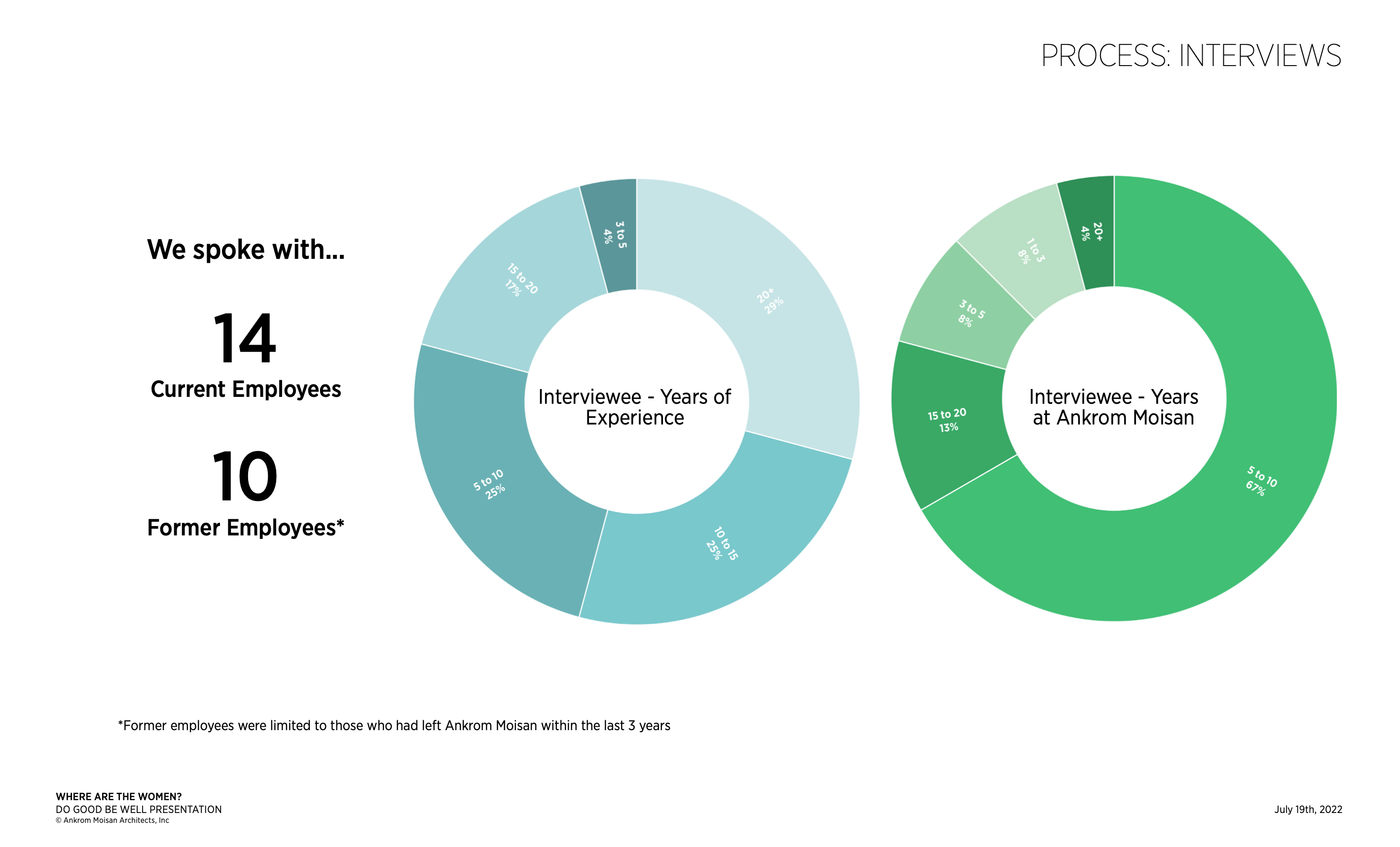
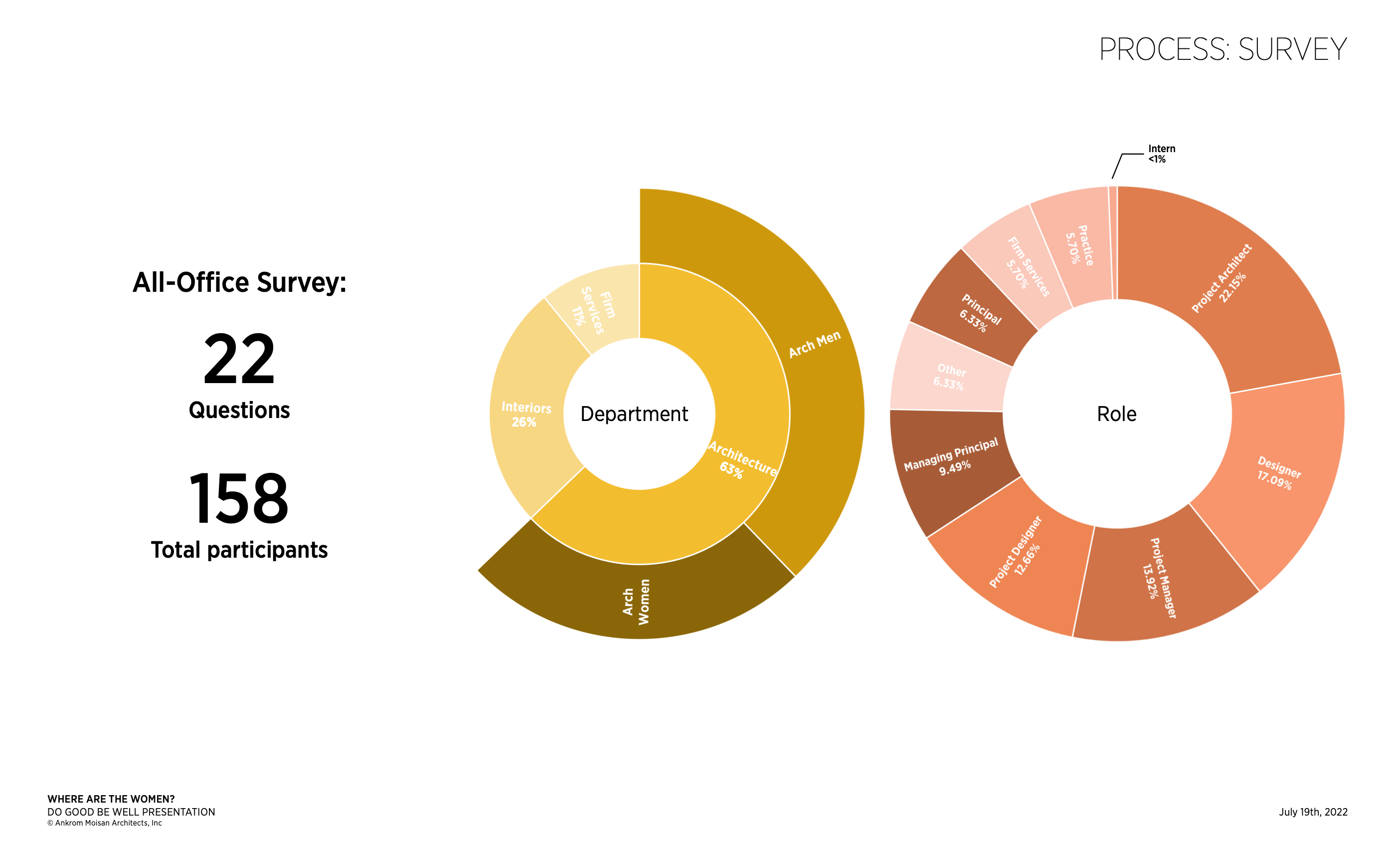
Graphs illustrating the research project’s interview and survey process.
Stephanie disclosed that the study they conducted was designed to provide “specific points that we could apply here at Ankrom to help [combat the disappearance of women from architecture].” The idea was that by identifying the roadblocks that women face when advancing in their careers, they will be able to more confidently advocate for themselves and the resources they need to grow as professionals. The research is an important first step in Ankrom Moisan’s journey to bringing gender parity to the architecture department and increasing diversity, equity, and inclusion in the firm overall.
Read part two, here, to learn more about what the research uncovered.

By Jack Cochran, Marketing Coordinator






